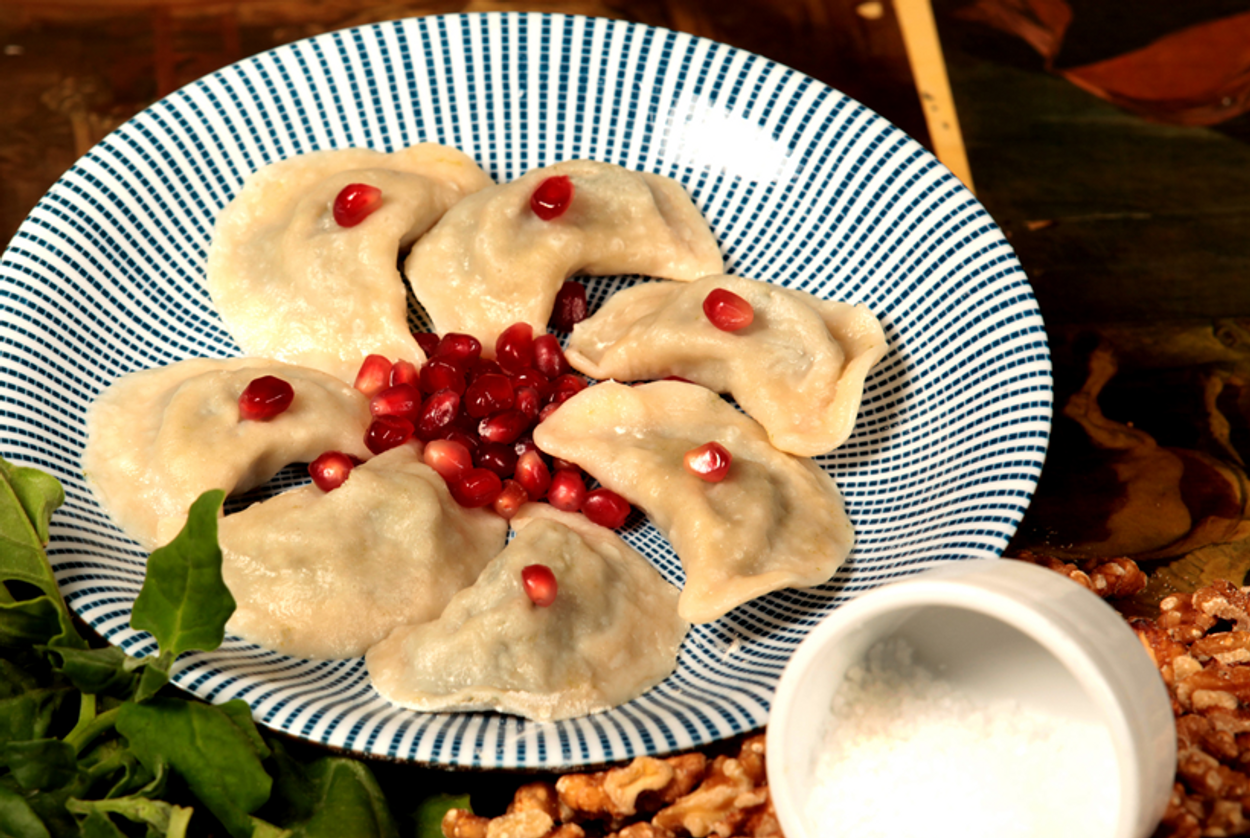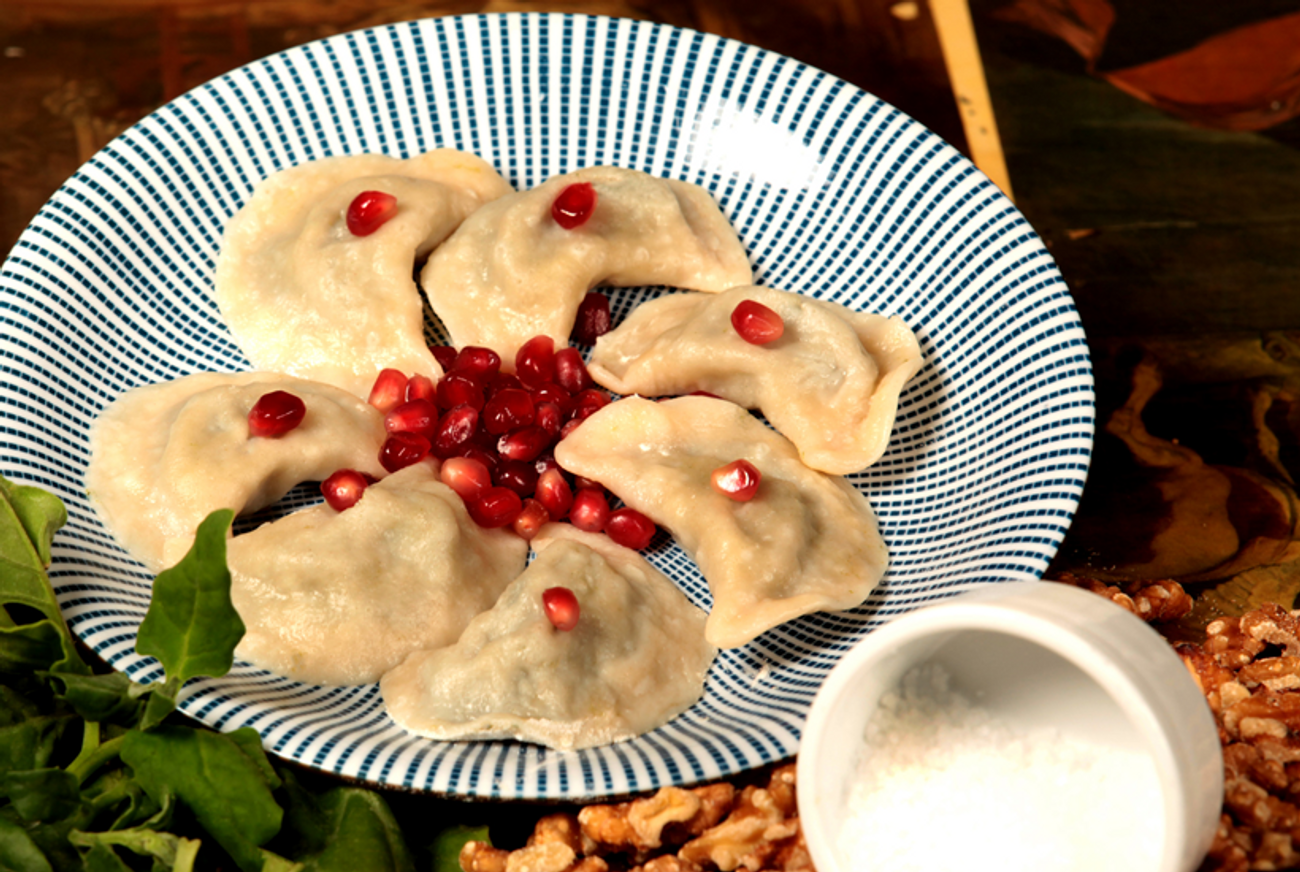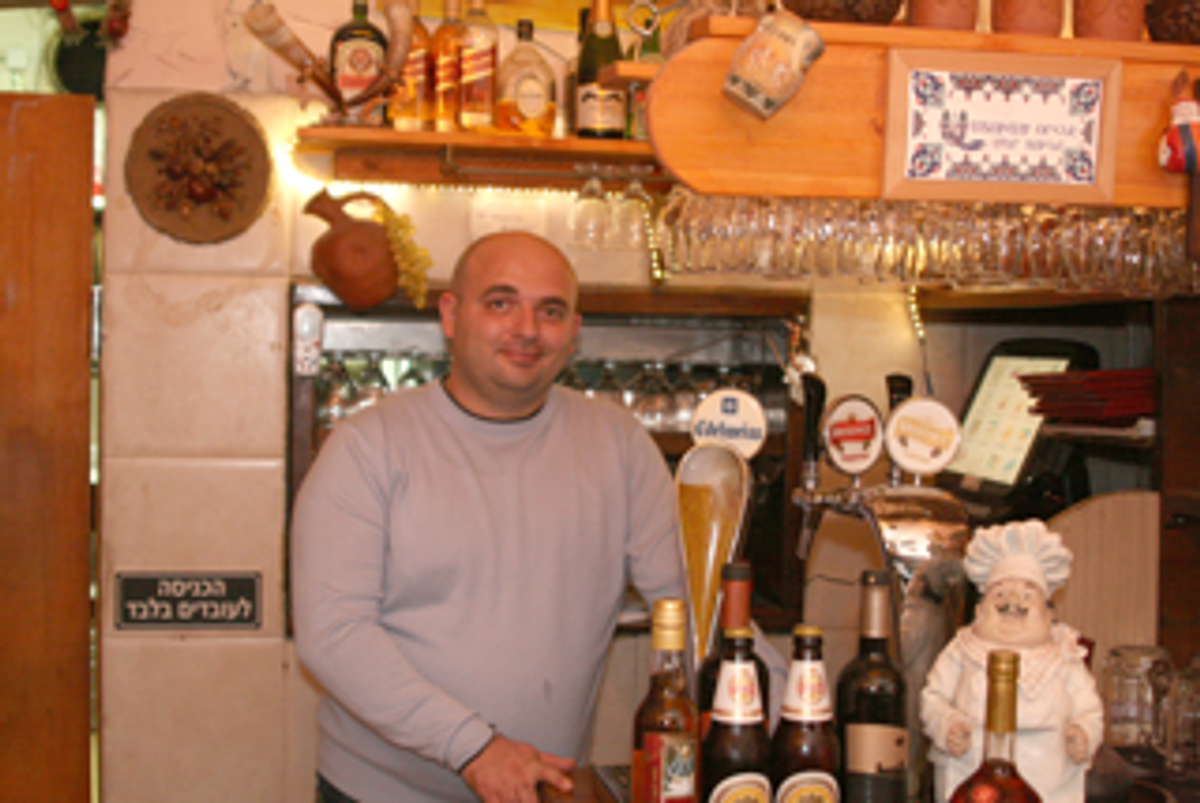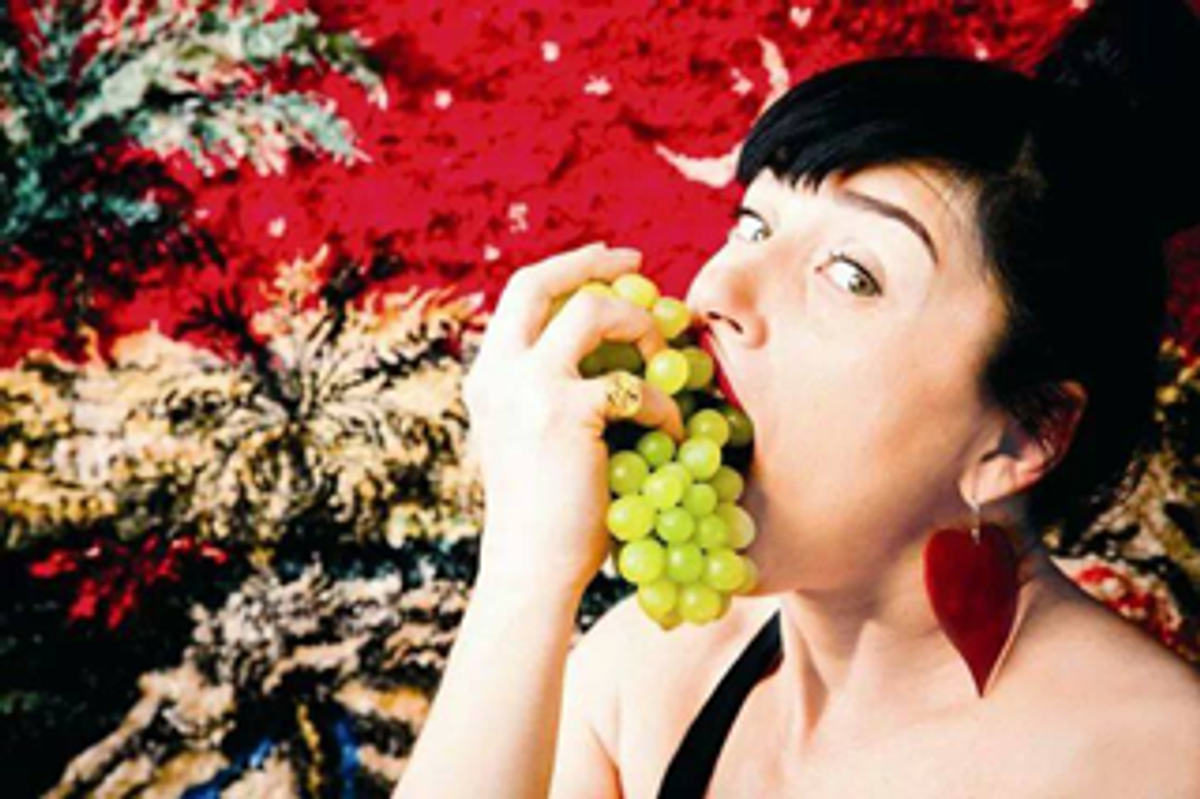Israelis Develop a Taste for Georgian Cuisine—and Put a New Spin on It
Immigrants from the former Soviet republic brought their recipes to Israel, where chefs and TV shows have made them popular




On a recent Sunday night in his restaurant Deda, owner Gor Oganesian showed me how to eat hinkali, a classic Georgian dumpling filled with a beef meatball and its broth, its dough twisted into a stem on top. He grabbed a softball-shaped dumpling by the stem, turned it over, dusted it with pepper, and handed it to me. Georgians, he showed me, eat hinkali by nibbling off a corner of the dough, sucking out the soup, and devouring all of the dumpling except for the stem.
Oganesian opened Deda, his first Georgian restaurant, about five years ago in Givatayim, outside Tel Aviv. The décor is modest: The walls are lined with grape trellises, and the tablecloths are embroidered with bright red patterns. But since it opened, Deda has become the anchor of a small Georgian empire that now includes three other branches where Israelis can come for down-home cooking from the former Soviet state.
The Jewish community of Georgia, a small country in the Caucasus Mountains, dates back more than 2,000 years. Most Jewish Georgians migrated to Israel after the Soviet Union collapsed, and they brought their recipes with them. Georgian food, which revolves around walnuts, fresh and dried fruit, herbs, dumplings, and hearty stews, has since captured a high rung on Israel’s culinary ladder. Thanks to a number of outstanding Georgian restaurants and a spate of appearances on televised cooking shows, hinkali (dumplings) and hachapuri (cheese bread) are becoming household terms in Israel. An agreement for visa-free travel between Georgia and Israel, signed this past November, is helping expose Israelis to the country’s food even more. And Israelis, of course, have started putting their own spin on Georgian food.
“Something like six or seven years ago, Israelis started traveling a lot to Georgia, and when they come back they are very excited and attracted to the Georgian kitchen and culture and people,” Oganesian said. “When they found us they started to come here to remember the good moments they spent in Georgia.”
***
Michal Ansky—a judge on the reality cooking TV show Masterchef, as well as the founder of the market at the Tel Aviv Port—fell for Georgian food when she flew there this year at the invitation of the country’s ambassador to Israel. “It was two hours from Israel, but nothing like the places nearby,” Ansky said. “Vegetables, fruits, and herbs—everything is organic because they just don’t use pesticides. It’s like going back 500 years when everything was seasonal, local, and fresh.” Ansky was so enchanted with the food she tasted that she is now planning to hold a weeklong Georgian Independence Day festival in her market in late May.

The best-known Georgian foods are what Ansky calls “the three pillars”: One is the meat dumpling hinkali. The second is hachapuri, a cheese bread that takes many shapes across the regions of Georgia. At Deda, it can be served as hachapuri Ajaruli, from the Ajaria region. (“It’s shaped like a boat,” Oganesian said, “because Ajaria is on the shore of the Black Sea.”) Last is churchkhela, a string of walnuts dipped in grape syrup and hardened into a sweet.
But those three pillars are only the beginning. Lily Ben Shalom opened the Jerusalem restaurant Racha two years ago, serving her mother’s Georgian food and featuring live music from her homeland on Sunday nights. Now she’s also a prominent contender on Game of Chefs, an Israeli reality TV show. She auditioned for the program as a way of showing her brother—the head of Racha’s kitchen—that she had cooking chops, too. She served the judges blini (crepes) and tkemali, a Georgian sauce made of green plums and herbs. Judge Moshik Roth, the only Israeli to earn two Michelin stars, said he could drink gallons of it.
Darra Goldstein, author of A Georgian Feast, traveled through Georgia to document the food. She said Georgians tell a fable about the beauty of their food: The first Georgians were seated at a table feasting on grilled lamb with plum sauce. They were so engrossed in their meal that they missed God’s deadline for giving out land to the world’s people. God went home and stopped to reproach the Georgians for their negligence. The Georgians toasted God for his generosity, and he gave them his own portion of land instead. “It shows very well the connection between the Georgians and the land, because they really love to eat outdoors,” she said. “It makes them feel closer to the source of their food, and it somehow makes them feel better.”
Goldstein said Georgians have a tableside institution of the Tamada toastmaster, who is trained to recite poetry, recount history, and tell the stories of the people at the table to build community. Those Tamadas toast with wine made from 500 uniquely Georgian grape varieties, fermented underground in clay casks. Israeli wine specialist Tal Gal Cohen said high-quality Georgian wines are increasingly available in Israel. He recommended Chateau Mukhrani wines made from the saperavi grape.
Another typically Georgian alcoholic drink is chacha, a grappa-like distillation of grape skins. Ansky said she spent most of her trip in Georgia mildly intoxicated from chacha served at breakfast, lunch, and dinner: “I sat for hours in a hot hammam eating hinkali. The hinkali you don’t eat, they fry and send back. It was just happiness and drinking chacha all day long.”
***
For the last two decades, Georgian restaurateurs in Israel have adhered strictly to the old recipes. Now they are starting to reflect the influence of their adopted country. Nana Shrier moved to Israel from Georgia when she was 4. She opened Nanuchka in Tel Aviv 14 years ago, and it has been known ever since for its abundant meat hinkali, its eclectic design, and its rowdy bar where middle-aged women dance well into the night.

In February, Shrier made waves when she converted Nanuchka to a vegan menu. “I started to see some pictures and movies, the way they treat the animals with a lot of suffering and misery,” Shrier said, “so I decided after a lot of thinking that I cannot serve animals anymore.” Now the walls are covered with portraits of the staff posed with eggplants and carrots. The hinkali (recipe here) are made with porcini mushrooms, the hachapuri with soy cheese.
When I met her, Shrier was sharing chacha with two elderly Georgian men and talking about the vegan lifestyle. David Yosebashvili refused to touch the mushroom hinkali—he said it had to have meat. Eliyahu Michaeli, however, said he was persuaded. “I have been convinced, and I think I have to be a vegan,” said Michaeli, 70, who was experimenting with vegan options for his catering company in Bat Yam. “Look, I’m 40 years in Israel, and I got used to being a little more modern than people used to be.”
***
Like this article? Sign up for our Daily Digest to get Tablet Magazine’s new content in your inbox each morning.
Daniella Cheslow is an American journalist covering the Middle East.
Mushroom and Lentil Hinkali
Courtesy of Nana Shrier, of Nanuchka restaurant in Tel Aviv
At Nanuchka, these are served with a few pomegranate seeds of strewn on top.
Dough:
2 cups white flour
2 cups durum flour
1 tablespoon olive oil
1 cup water
Filling:
1 1/2 cups green lentils soaked in water for 3 hours and cooked until soft
1 basket of champignon mushrooms, chopped
1 chopped leek
2-3 cloves of garlic
Nutmeg
Salt
Pepper
Vegetable oil
Directions:
1. Prepare the dough: Pour the flours, the oil, and half a cup of water into a bowl and mix. Knead and slowly add water until the dough gets a uniform and slightly flexible dough (do not overknead). Cover the dough in plastic wrap and place in the refrigerator for an hour.
2. Prepare the filling: Heat a bit of vegetable oil in a pan. Add the leeks and mushrooms and a small amount of water and cook for 2-3 minutes until the vegetables soften. Season with salt, pepper, and nutmeg.
3. In a food processor, grind the lentils with the garlic and pour into a bowl. Add the leek and mushrooms and mix well.
4. Roll out the dough in a pasta machine into sheets with a thickness of 2 (or roll uniformly by hand). Use a glass to cut circles from the dough. Place about a tablespoon of filling on each circle. Fold the dough over and close the seam well.
5. Bring a pot of salted water to a boil. Cook the hinkali for about eight minutes in bubbling water, until they float. Remove with a slotted spoon and serve.
Makes 45 dumplings
Daniella Cheslow is an American journalist covering the Middle East.